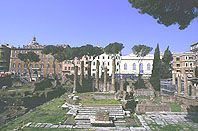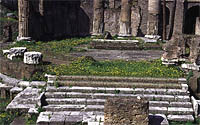Pantheon's Area
Largo di Torre Argentina
 Little is known about these fascinating remains of marble temples from Ancient Rome's Republican era - before the Empire. They were excavated during the years 1926-35 by order of Mussolini, who was trying to glorify his own imperial ambitions.
Little is known about these fascinating remains of marble temples from Ancient Rome's Republican era - before the Empire. They were excavated during the years 1926-35 by order of Mussolini, who was trying to glorify his own imperial ambitions.
The ruins of 5 temples (6 th to 2 nd centuries BC) are identified only by letters, reading from North to South in the direction of the Tiber River.
Temple A, probably 3C BC, was restored by the Emperors and later topped with a Medieval Church - which was removed, though traces of its curved apses remain.
In the center is the most recent, Temple B, which honors a deity called Today's Good Fortune ("Fortuna Huiusce Die"). It was built by Q. Lutatius Catulus, who had vowed to do so when he had the "good fortune" to win the Battle of Vercellae in 101 BC against the pesky neighboring tribes from the North. It has an elegant circular form with a fine mosaic and 6 of the original 18 columns still survive. 
Between these two temples is Temple E, built during the Roman Empire.
The earliest, Temple C dates from the end of the 4C BC and beginning of the 3C BC; raised on a podium, it had columns on three sides.
Temple D, mostly still covered by Via Florida, dates from the early 2C BC but was rebuilt a century later. That brick pile behind Temple B is all that remains of the part of Pompey's Theater in which the Senate was meeting on 15 March 44 BC when Julius Caesar was stabbed to death by his fellow senators. Behind Temple A is a line of the marble latrines dating from Imperial times.